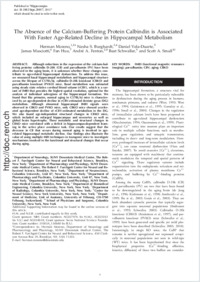The absence of the calcium-buffering protein calbindin is associated with faster age-related decline in hippocampal metabolism
- Moreno, Herman Department of Neurology, SUNY Downstate Medical Center, Brooklyn, New York, USA - Department of Pharmacology and Physiology, SUNY Downstate Medical Center, Brooklyn, New York, USA
- Burghardt, Nesha S. Department of Neuroscience, Columbia University, New York, USA - Department of Pharmacology and Psychiatry, Columbia University, New York, USA
- Vela-Duarte, Daniel Department of Pharmacology and Physiology, SUNY Downstate Medical Center, Brooklyn, New York, USA
- Masciotti, James Department of Biomedical Engineering, Columbia University, New York, USA
- Hua, Fan Department of Radiology, Columbia University, New York, USA
- Fenton, André A. Department of Pharmacology and Physiology, SUNY Downstate Medical Center, Brooklyn, New York, USA - Center for Neural Science, New York University, New York, USA
- Schwaller, Beat Department of Medicine, Unit of Anatomy, University of Fribourg, Switzerland
- Small, Scott A. School of Physicians and Surgeons, Columbia University, New York, USA
-
18.04.2011
Published in:
- Hippocampus. - 2012, vol. 22, p. 1107-1120
English
Although reductions in the expression of the calcium-buffering proteins calbindin D-28K (CB) and parvalbumin (PV) have been observed in the aging brain, it is unknown whether these changes contribute to age-related hippocampal dysfunction. To address this issue, we measured basal hippocampal metabolism and hippocampal structure across the lifespan of C57BL/6J, calbindin D-28k knockout (CBKO) and parvalbumin knockout (PVKO) mice. Basal metabolism was estimated using steady state relative cerebral blood volume (rCBV), which is a variant of fMRI that provides the highest spatial resolution, optimal for the analysis of individual subregions of the hippocampal formation. We found that like primates, normal aging in C57BL/6J mice is characterized by an age-dependent decline in rCBV-estimated dentate gyrus (DG) metabolism. Although abnormal hippocampal fMRI signals were observed in CBKO and PVKO mice, only CBKO mice showed accelerated age-dependent decline of rCBV-estimated metabolism in the DG. We also found age-independent structural changes in CBKO mice, which included an enlarged hippocampus and neocortex as well as global brain hypertrophy. These metabolic and structural changes in CBKO mice correlated with a deficit in hippocampus-dependent learning in the active place avoidance task. Our results suggest that the decrease in CB that occurs during normal aging is involved in age-related hippocampal metabolic decline. Our findings also illustrate the value of using multiple MRI techniques in transgenic mice to investigate mechanisms involved in the functional and structural changes that occur during aging.
- Faculty
- Faculté des sciences et de médecine
- Department
- Département de Médecine
- Language
-
- English
- Classification
- Biological sciences
- License
-
License undefined
- Identifiers
-
- RERO DOC 27215
- DOI 10.1002/hipo.20957
- Persistent URL
- https://folia.unifr.ch/unifr/documents/301918
Other files
Statistics
Document views: 207
File downloads:
- pdf: 258
- Supplementary material: 123

